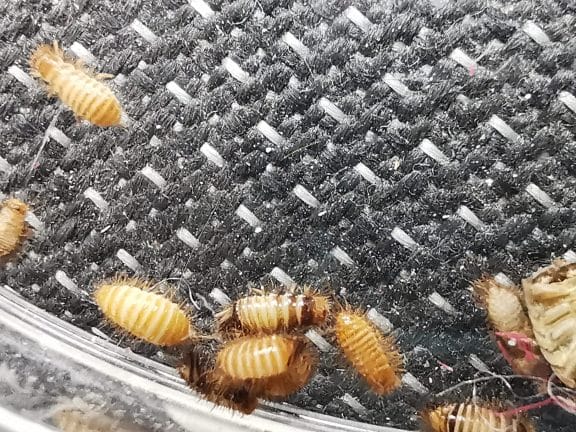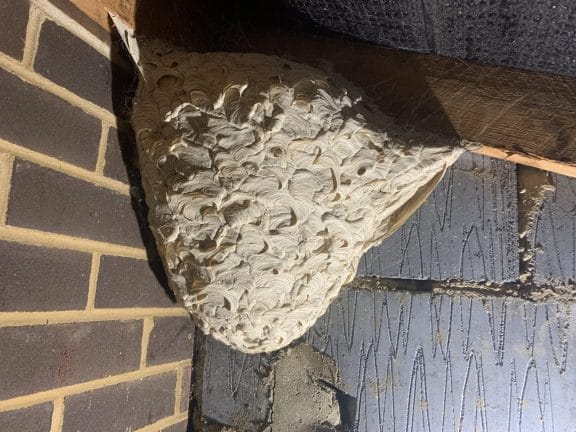Updated On 15/10/2024
Carpet beetles are a common pest in UK homes, but many homeowners know very little about them. Often mistaken for clothes moths or bed bugs, carpet beetles are oval-shaped insects that can damage your property and cause skin irritation.
Pest-Tech has extensive experience in carpet beetle removal, so we understand how difficult these tiny critters can be. Generally, the problem is not the adult beetles but the larvae, which are known as woolly bears. Woolly bear larvae are so dangerous because they eat voraciously and will decimate organic materials.
To help you understand carpet beetles and identify a potential infestation, we’ve created this guide. It explores not only the question of how to get rid of carpet beetles but also shares what they are, how they get into your space and a case study on how our team professionally eradicated an infestation.
What Are Carpet Beetles?
In the UK, there are several types of carpet beetles. The most common are varied carpet beetles, also known as variegated carpet beetles, as well as furniture carpet beetles and black carpet beetles.
Adult carpet beetles live for between 2 and 6 weeks, during which time a female beetle will produce as many as 100 eggs. Adult beetles eat flower pollen and so aren’t particularly dangerous, but it is the carpet beetle eggs and the larvae they produce that can cause issues.
Once the eggs hatch into larvae, they will spend between 7 and 10 months feeding on natural fibres such as wool, silk, leather and velvet.
Carpet beetle woolly bear larvae will eat almost anything, not just carpets. They will also devour clothes, upholstered furniture, pet hair, taxidermied animals, stored products such as dried grains and dead insects.

How Do Carpet Beetles Get Into Your Home?
Adult carpet beetles prefer to crawl around your home, but they are able to fly. As such, carpet beetles can be introduced to the home by simply flying through open windows in your house. They are attracted to freshly cut flowers, but nesting birds can also introduce an infestation. Carpet beetles head for natural light, so you do find them dead on window seals. This can be a sign that you have a problem.
As mentioned, the adult carpet beetle isn’t particularly dangerous, but their larvae are a major British textile pest, so they eat natural fibres such as fabrics and wool. They eat regularly and can cause a lot of damage in a short period of time. The larvae will be hatched in your home by the carpet beetle adults and can cause serious damage to your furniture, carpets and other household items. The varied carpet beetle is small in size and has a vibrant blue and brown wing case, so they’re very distinctive.
Signs Of A Carpet Beetle Infestation
Noticing a carpet beetle infestation isn’t always easy, especially not at first. These tiny beetles can be difficult to see with the naked eye. Thankfully, there are several tell-tale signs of carpet beetle activity, including:
- Holes In Fabrics: Clusters of holes in fabrics, upholstered furniture, blankets, curtains and other materials could indicate carpet beetles.
- Bare Patches On Carpets And Rugs: Carpet beetle larvae will eat rugs and carpets, leaving large bare patches.
- Shed Skins: Adult beetles shed their skins multiple times during their life cycle and will leave behind the shed skins throughout your property.
- Carpet Beetle Eggs: It’s hard to see these tiny, off-white sacs as they’re so small, but you might notice clusters of them in fabric folds.
- Carpet Beetle Droppings: Small brown or black carpet beetle droppings, which look like spilt peppercorns or coffee grounds, could be a sign of an infestation.
Carpet Beetle Treatment Case Study
This is an example of how Pest-Tech was able to remove carpet beetles from a property. We were called out by a customer who had two treatments from a different pest control company. Although two treatments had been completed by the other pest controller, the client was still finding carpet beetle larvae crawling about.

Initially, it was throughout the house, but now it was just in the kitchen and bathroom upstairs. A survey was carried out, and it was found that the areas still experiencing the problem were linked by a small loft space. This had been missed during previous treatments, so it needed checking. On looking inside, woolly bear cases were found throughout the insulation, and there were two old wasp nests in there. A wasp nest is made of wood pulp, which is a natural fibre and food source for woolly bears.

To get rid of the carpet beetle infestation, we removed the insulation and the two wasp nests from the small loft area and bagged it all up. The area was then hoovered up, and a spray treatment was completed to deal with any stragglers in the area. After inspecting the wasp nest outside, we found that the nest was completely infested with larvae. This was no doubt the source of the problem and would have continued to house the infestation.

By being thorough in our inspection of the property, we were able to find the source of the carpet beetle problem and remove it. As a result, the customer was able to finally be rid of carpet beetles and enjoy their property again.
How To Prevent Carpet Beetles
Preventing future infestations is possible, but it takes time and effort. It’s also not guaranteed, as, like many other insect pests, carpet beetles are very small and difficult to see.
The best way to prevent beetles is to cut off their food sources. That means you should regularly vacuum your home, particularly all floor coverings such as wool rugs and thick carpets, to get rid of dust formulations, dead skin and animal hair if you have pets. Good housekeeping practices will reduce food sources for carpet beetles and make an infestation less likely to take hold.
Additionally, consider dry cleaning any secondhand items that are made from organic materials, such as rugs or curtains, to prevent carpet beetles from being transferred into your home in this way. Washing them in hot water can kill carpet beetles and their eggs that might be lurking deep in the fabric.
If you see bird nests on your property, work with professional bird control experts to deter the birds, as their nests can cause carpet beetle and bird mite infestations.
By being proactive, you can reduce your chances of dealing with carpet beetles. If you do face an infestation, it’s important that you work with the experts to get rid of these destructive insects fast.

How To Get Rid Of Carpet Beetles: Conclusion
Ultimately, getting rid of carpet beetles can be tough. Even if you clean infested areas, the woolly bear larvae can hide deep in the carpet or your furniture, and you may soon be finding carpet beetles in your home again.
While some people claim that natural remedies, such as food-grade diatomaceous earth or even essential oils, can get rid of carpet beetles, the fact is that these methods can be dangerous and ineffective. If used incorrectly, these products could harm your health and your pets without getting rid of your carpet beetle problem.
To remove carpet beetles and kill larvae throughout your home, you need experience and the right equipment. You also need to make sure you check anywhere carpet beetles lay eggs- this might not be an obvious area, as demonstrated in our case study.
Thankfully, Pest-Tech is here to help with our professional carpet beetle treatments. As members of the BPCA, our team has the skills and experience needed to identify and remove a carpet beetle infestation of any size. We operate throughout Maidstone and Kent and can provide domestic or commercial carpet beetle pest control treatments. Call 01622 296055 to book your carpet beetle control treatment today.
